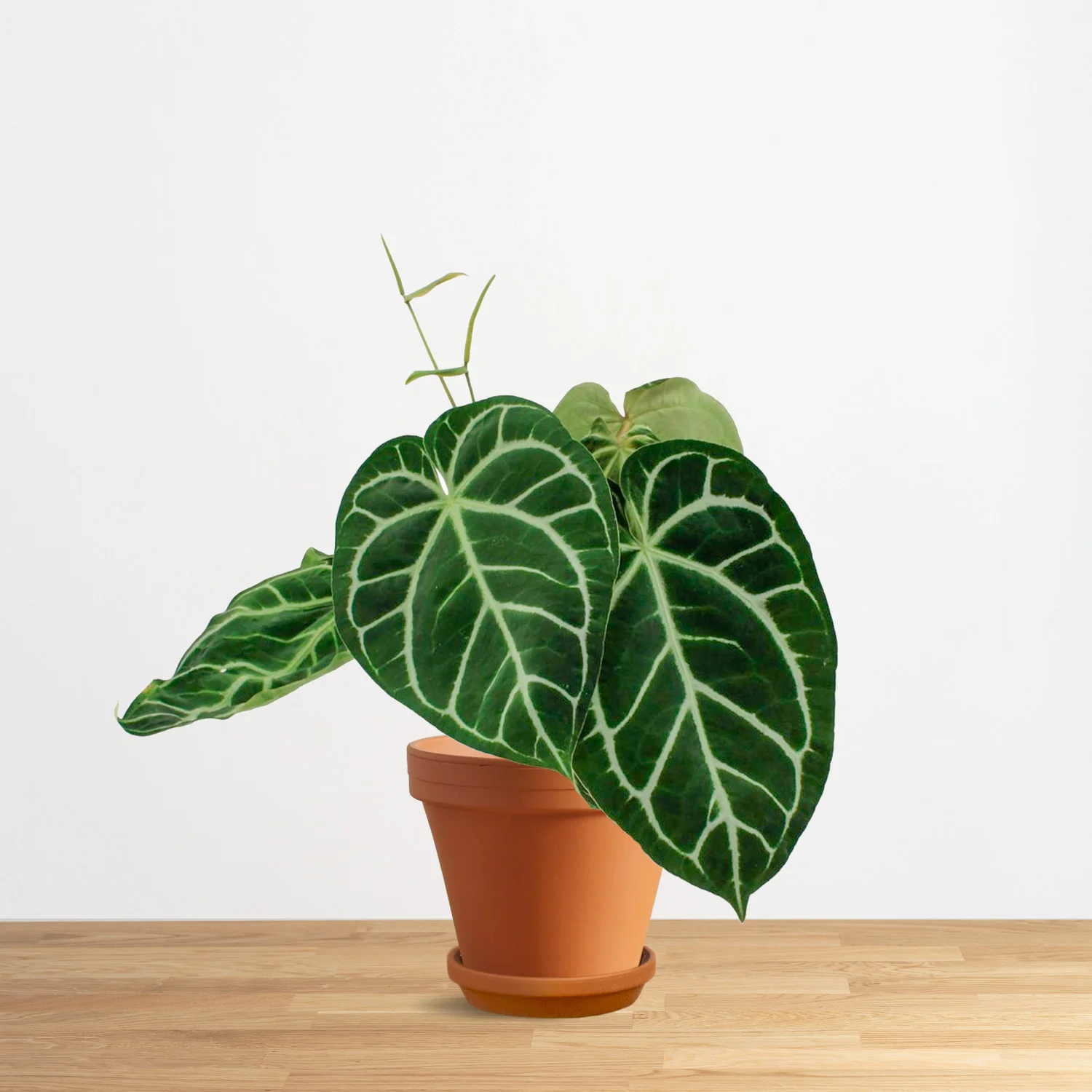Anthuriums are gorgeous tropical plants known for their lush green leaves and bright, heart-shaped blooms. Though beautiful, anthurium plants have a few secrets you need to unlock to grow them to their true potential and keep them thriving in any home environment.
1. Choosing the Right Anthurium for You
Anthurium plants come in a wide range of varieties with different features. In order to thrive your anthurium, you’ll need to select the right variety based on factors like size, light requirements, humidity preferences, and more. Matching your plant to your growing conditions is key.
Small Size or Large Variety
Anthurium varieties cover a size range from tiny 6-inch plants to massive specimens over 6 feet tall. For container growth, consider:
- Small anthuriums: Flamingo anthrium, Midnight anthurium, and Baby anthurium are small types under 12 inches tall, perfect for tables and shelves.
- Medium-sized anthuriums: Anthurium Magnificum, Anthurium Crystallinum, and Anthurium Waterburyanum grow 12-36 inches tall. These varieties work in slightly larger containers.
- Large anthuriums: Velvet cardboard anthurium and Pistache anthurium can grow over 3 feet tall and require big containers or planted into the ground.

Lighting Needs
Accommodating your anthurium plant’s light needs is crucial. Varieties include:
- Low light anthuriums: Anthurium Clarinervium and Flamingo thrive in bright indirect light but tolerate low light. Perfect for dim indoor spaces.
- Medium light anthuriums: Most common red, pink, or orange flowering types need several hours of bright filtered light. Ideal for atriums or brighter rooms.
- Bright light anthuriums: Varieties like the Sarian anthurium or Giant White anthurium flower best in 4 or more hours of direct sunlight. Place in sun rooms or Southern windows.
Humidity Preferences
Native to humid tropical rainforests, anthuriums thrive best in high humidity levels between 50-90%. However, some varieties tolerate drier air better than others. Assess your household humidity before choosing a plant.
- High humidity varieties: Waterburyanum and Crystallinum anthuriums require 60%+ humidity to avoid dried leaf tips. Best for humid bathrooms or terrariums.
- Moderate humidity varieties: Flamingo, Midnight, and Heartbreakers anthuriums adapt well to 45-60% average indoor humidity. The most broadly suitable for most homes.
- Low humidity varieties: Sheer Curtain anthuriums and flowering anthurium obake varieties are the most tolerant of dry air, handling well at 40% humidity levels or less. Best pick for drier areas.
Growth Habit
Anthuriums come in either vining or compact non-vining varieties. Assess the space you have available before deciding which habit is best:
- Vining anthuriums: Heartbreakers, Clarinervium, and Crystallinum varieties have trailing stems that spread. Allow horizontal space or provide plant supports.
- Upright anthuriums: Flamingo, Midnight, Magnificum and more varieties have short, upright stems that grow compactly. Require less space and are self-supporting.
2. Providing Proper Anthurium Potting Mix
Selecting the optimal anthurium potting medium provides healthy roots that power lush growth. Make your own mix tailored to drainage, nutrients, and moisture control.
“Explore the Exceptional 2023 Anthurium Collection: A Curated Selection of the Rarest and Most Unique Varieties Available.”

Creating Fast Drainage
Anthurium roots rot easily in wet soils. Create highly porous, well-draining mixes instead using:
- Orchid barks and perlite: Orchid barks chips create air pockets while perlite supplies drainage. Blend at a 2:1 ratio for at least 50% of total mix.
- Hardwood or fir tree charcoal: Charcoal’s porous surface aerates soil. Add approximately 15% charcoal pieces for extended drainage.
- Pea gravel or pumice: Mix in 10% pea gravel rocks or porous volcanic pumice to enhance drainage.
Too much fast-draining material excessively desiccates soil though. Include some moisture retention too.
Adding Moisture-Retentive Ingredients
While requiring good drainage, anthurium roots also appreciate steady access to moisture between waterings. Provide this with:
- Sphagnum or coco coir: Chopped coco coir fibers or milled sphagnum peat moss retain water to hydrate nearby roots. Include approximately 15% in mixes.
- Compost, worm castings, or composted manure: These nutrient-rich organic amendments boost moisture retention. Blend in 10% for water storage and slow-release feeding.
- Time-release water gel beads: Optionally sprinkle a small 2% portion of hydrophilic polymer gel beads into any anthurium soil recipe. Absorbs water then gradually releases it back to plant roots.
Integrating Slow-Release Fertilizer
Anthuriums thrive best with continual light feeding. Amending potting media with:
- Controlled-release fertilizers: Coated granules slowly diffuse 3-4 months of nutrients. Layer the lower 1/3 of container with Osmocote or Nutricote pellets.
- Natural organic fertilizers: Mix worm castings, alfalfa meal, fish bone meal, wood ash, etc. throughout soil for gradual feeding.
- Activated biochar: Charged with microorganisms, biochar offers nutrients and boosts soil fertility over months. Add 5% biochar to support microbial activity.
Premixed commercial anthurium soils blends are also available with integrated slow-release nutrition.
3. Mastering Proper Anthurium Watering Techniques
Providing your anthurium plant with just the right amount of water on a consistent schedule is critical to thriving growth. Learn timing cues and best watering methods.

Judging When to Water
Rather than fixed schedules, water plants based on assessing soil dryness through:
- Feeling potting mix: Insert your finger into the top few inches of soil. Water when mostly dry. The deeper layer should still feel lightly moist.
- Seeing soil color change: Soil darkens when wet, lightening as it dries. Water lighter soils.
- Plant cues: Signs like drooping leaves often indicate needs watering. Allow soil to nearly dry between waterings though to avoid root issues.
Watering Best Practices
Proper technique for water application helps support plant health by:
- Watering thoroughly: Apply enough liquid to soak soil throughout the entire pot depth. Drainage from bottom holes indicates saturated media needed for moisture distribution into lower roots.
- Aerating soil after: Allow excess moisture to gravity drain then use a small stick or skewer to gently poke holes releasing trapped interior air pockets that can block oxygen from reaching roots.
- Watering onto foliage: Misting plant leaves allows them to absorb supplemental liquid through leaf pores. Just be sure surfaces completely dry by night to prevent fungus issues. Consider a pebble tray for evaporative boosting.
- Using purified or rain water: Chlorine and minerals in harder tap waters contribute to unsightly leaf tip browning over time. Filtered, distilled, or collected rainwater avoids damage.
- Managing inconsistent saturation: Rotate pots regularly so all sides receive even moisture. Use gauges to determine when to redistribute leveling.
4. Optimizing Anthurium Light Levels for Growth
While most popular as houseplants, anthurium plants originate in well-lit rainforest environments. Tailor lighting for your variety to achieve healthy development.

Assessing Lighting Needs
Anthuriums range significantly in preferred illumination, with factors like:
- Natural habitat brightness: Lowland or higher elevation origins indicate jungle floors or bright tree canopies.
- Leaf coloration: Darker foliage requires more light to avoid elongation and chlorosis. Colorful varieties also intensify with increased exposure.
- Growth orientation: Upright stance and broader leaves capture more light than vining types with vertical foliage.
- Flowering: Blooming varieties need higher intensity than non-blooming anthurium grown for foliage.
New growth and leaf color offer visual indications if current lighting satisfies needs.
Optimizing Natural Light Conditions
Position plants advantageously in suitable window exposures:
- Southern or slightly shaded: Intense direct southern sun suits anthuriums needing highest illumination, like Sarian. Sheer curtains diffuse glare.
- Eastern or western windows: Bright morning eastern light or afternoon western exposures work well for most flowering or color varieties.
- Northern windows: Low light green varieties tolerate cooler northern views lacking intensity. Supplement with grow lights.
Additionally rotate pots regularly so all sides receive symmetrical light preventing leaning stems.
Using Artificial Supplemental Lighting
Modern LED grow lights help anthuriums thrive indoors by:
- Offering intensity control: Adjustable LED panels or hanging pendants allow customization from 200μmol/m2/s for low light varieties up to 1000μmol/m2/s levels for max growth.
- Providing full spectrum profiles: Mixes of cool and warm diodes include ultraviolet and far-red wavelengths that influence blooming and development beyond basic visible light.
- Running on flexible automated schedules: Smart WiFi-connected grow light systems integrate with Alexa or phone apps for customizable operation times.
Position LED panels to one side preventing shadowing or hang pendants above to evenly blanket plants. Use height adjustments to get intensity right.
5. Humidity, Air Circulation, and Temperature Parameters
Being native to steamy tropics, anthurium plants greatly benefit from high humidity while also requiring good airflow and warm temps. Tailor environmental conditions.
Methods For Raising Humidity Levels
With 60% humidity ideal for most anthurium varieties, consider home modifications like:
- Grouping plants together: Filling an area with many verdant plants boosts transpiration adding moisture to the immediate vicinity.
- Using pebble trays: Fill shallow trays with decorative stones and water. Setting pots on top allows evaporating mist to envelop plants.
- Installing humidifiers: Ultrasonic or evaporative home humidifiers release large amounts of fine mist. Position near plants for direct humidity benefits.
- Placing in bathrooms: Showers and baths generate temporary humidity spikes within bathrooms. Put anthuriums on counters away from direct moisture.
Ensuring Adequate Air Circulation
While appreciating gently moving air, intense blasts directly on leaves risks desiccation. Promote healthy circulation through:
- Small fans: Direct 6-8 inch diameter fans towards walls or corners to create room air patterns that indirectly move foliage.
- Natural convection: Locate plants on exterior walls where rising heat creates thermal currents. Position out of chilling draft pathways.
- Ventilating enclosed spaces: Use louvered doors, fans, or brief window openings to exchange stagnant indoor air in greenhouses or plant rooms.
- Avoiding crowded conditions: Give each plant adequate space for surrounding air movement, preventing closed humid pockets around stems that encourage fungal or bacterial issues.
Maintaining Suitable Temperatures
Originating from tropical environments, anthuriums grow best in warm conditions between 60-80°F, with consideration that:
- Cool spells: Brief exposures down to 50°F won’t damage plants, just slow growth. Move pots out of chilling drafts.
- High heat: Temperatures up to 90°F are tolerable if humidity remains high as well, but prolonged exposure risks burning leaf edges.
- Fluctuations: Instead of fixed temps, varying within the ideal range encourages blooming and healthier expansion.
Combining Conditions For Success
When humidity, airflow, and temperature parameters align consistently, anthurium plants truly thrive and reward growers with vigorous bounties of lush foliage accented by spectacular tropical blooms year-round.
Conclusion
Unlocking the secrets to prospering with anthurium houseplants involves choosing suitable varieties, creating an ideal fast-draining potting mix, mastering moisture provision techniques, optimizing light exposure, and providing ideal humidity, air flow, and warmth. Tailoring care methods to your unique home growing area allows anyone to succeed growing these tropical jungle natives into stunning specimens overflowing with gorgeous leaves and flowers.
See more 5 Amazing Benefits of Anthuriums: Transform Your Home Now!

